"Keep up the good work, if only for a while, if only for the twinkling of a tiny galaxy." -Wislawa Szymborska
You all know about shooting stars.
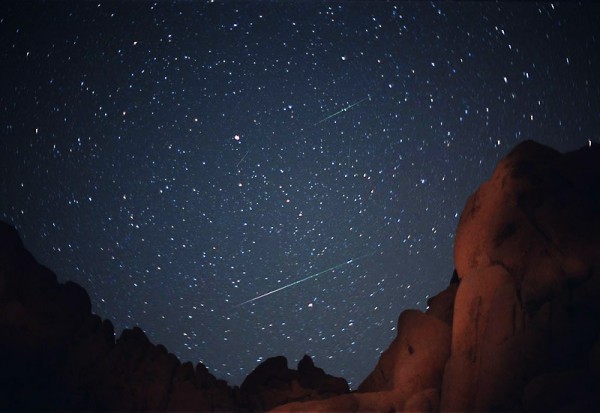
Seen from Earth, mostly during meteor showers, these aren't stars at all, but are tiny fragments of rock that hit the Earth's atmosphere, and streak across it, leaving a bright fireball as it burns up. If you're a great (and lucky) astrophotographer, you can nab a picture of one close up as it burns up.
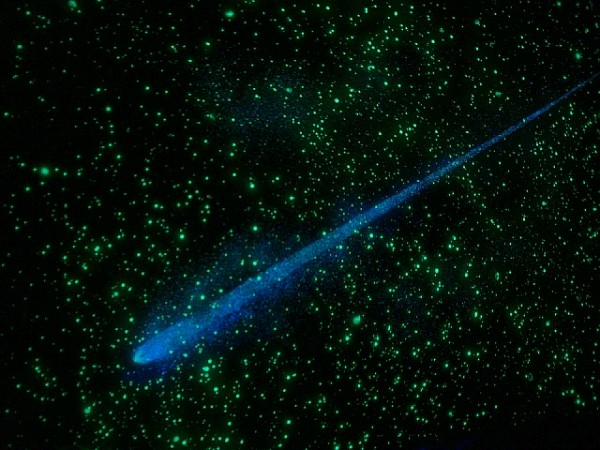
But this principle, that a fast-moving object traveling through space will run into whatever matter is in its way, leads us to some amazing observations. It hardly matters whether you're shooting a meteor through the Earth's atmosphere or a bullet through water; the results are spectacular.

The fast-moving object runs into the matter, collides with it, and feels the resistive effects of whatever it's passing through. For pretty much anything, it heats up and slows down.
What do I mean by "pretty much anything?" Take the star, Mira, for example. (Full story here.) Zooming through our galaxy at a whopping 64 km/s relative to the rest of the stars and gas in there, Mira's "matter" that it passed through is all of the interstellar gas and dust.
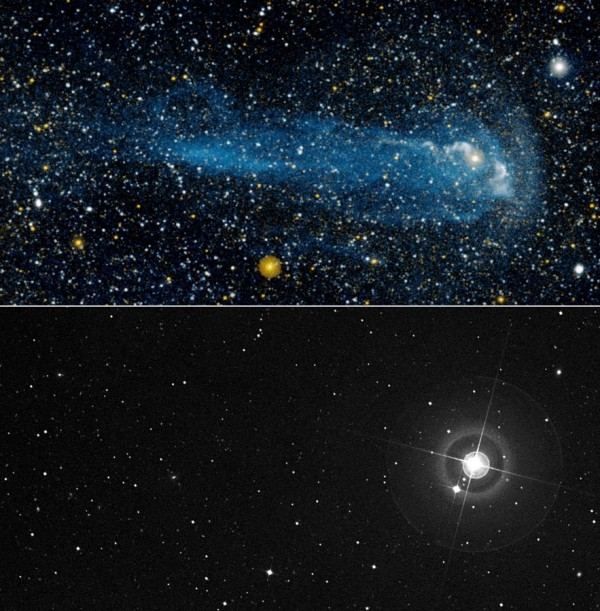
But while it looks like a normal star in the visible (bottom), the Ultra-Violet light (taken by Galex, top) shows the dramatic effects of friction. A small fraction of the outer layers -- where the gas is most diffuse -- actually get stripped off of the star, leaving a wake of hot gas behind it! Mira, in other words, is a real star that's actually shooting through our galaxy.
But what about a shooting galaxy?
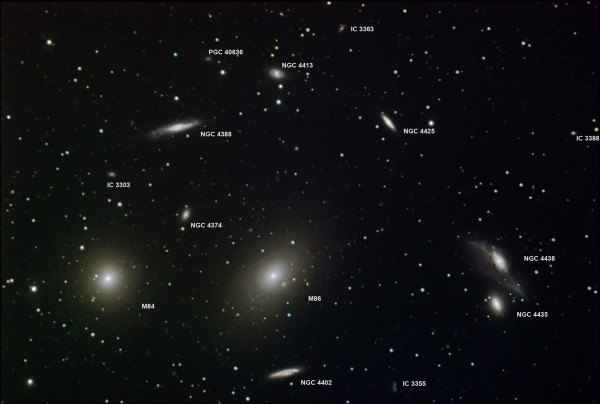
Our large, spiral galaxy is pretty lonesome. Sure, a couple of million light years away lies Andromeda, another large spiral. But for tens of millions of light years, that's it. No other large galaxies. Yet, if you look at the image above, you'll see that in some regions of space, there are many, many large galaxies clumped close together. This is just a small part of the Virgo Cluster, the closest large cluster of galaxies to us, with about 1,300 galaxies within about 7 million light years of one another.
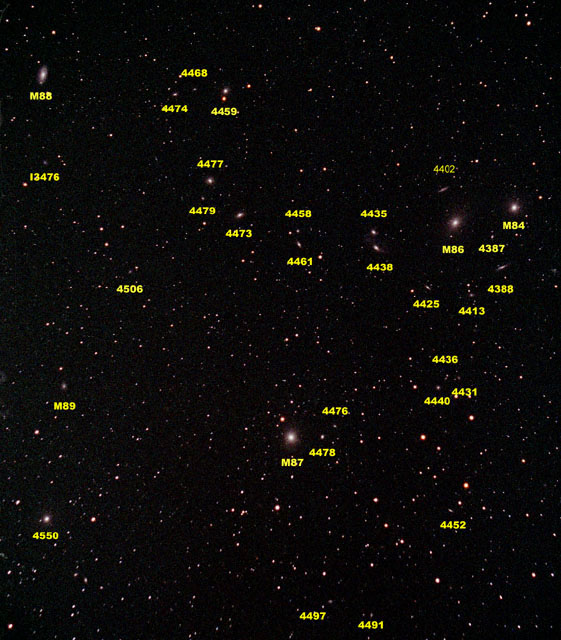
On the outskirts of the Virgo cluster is an innocuous, nondescript galaxy named IC 3418. Have a look.
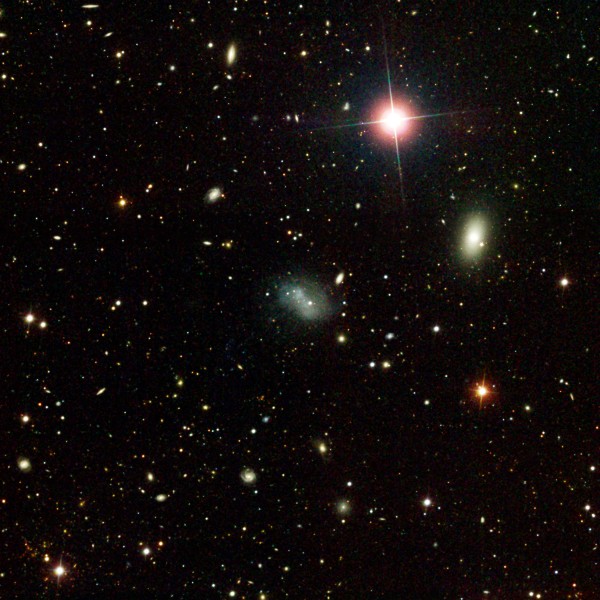
Unlike the other galaxies in the cluster, however, IC 3418 is being pulled towards the center of the cluster for what appears to be the very first time! It's moving at over 1,000 km/s towards the center of Virgo, or about 0.3% the speed of light.
And it's an entire galaxy!
So where's its tail, you ask? Where's all the evidence of this "friction" we're supposed to see? Well, just like with Mira, you need to look in Ultraviolet light once again.
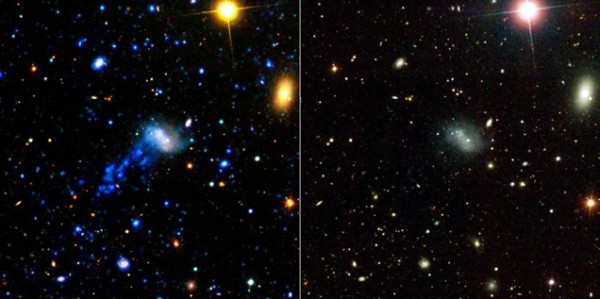
(Thanks again, Galex!) Not only is there a tail there, but if we look close at this galaxy, we can see that something spectacular is happening to the gas getting left behind in the wake of this galaxy.
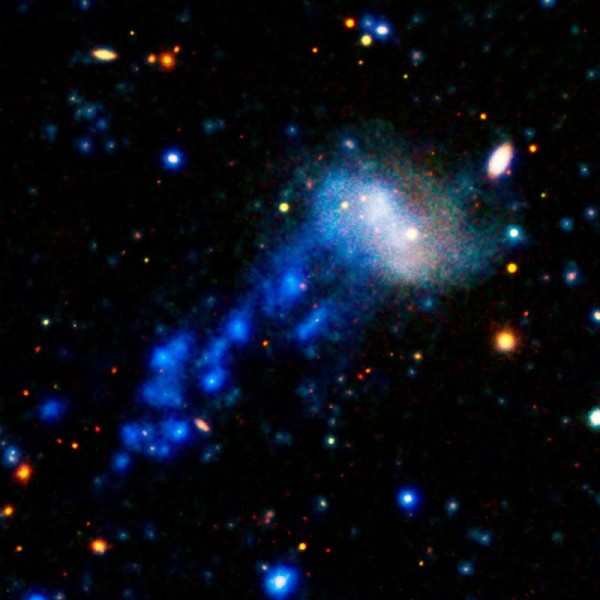
Under its own gravity, the stripped gas is combining with the intergalactic medium and collapsing to form stars! These are hot young stars, and those are the incredibly bright spots you see in the Ultraviolet image above. In other words, a shooting galaxy leaves not a tail, not some dust, but a trail of new stars in its wake.
And that's what a shooting galaxy looks like!

*speechless*
That's up there in contention to be the coolest thing ever.
Whoa,,,,,,,,,,,,, Now THAT...is cool!
Whoa +1
Wow. Incredible and exciting.
When I saw that "Entire Galaxy" image I thought, Ooh, Clumping! Then I read the caption. I win a donut. :)
Maybe there's a PhD thesis in that: modeling the turbulence of the trailing hot gas as it is affected by stars and gases in the galaxies it's moving through. A good model would predict the clumping that we see here ⦠and possibly make predictions of what they would look like in the future. It would be neat if some odd collection of stars could be thus identified as the result of a similar event in the distant past.
Thanks for showing me a cool thing.
http://wdpk837.whoisbenhustis.com/wp-content/uploads/2009/07/neo_whoa_1…
reminds me of something out of conway's game of life.
Ok, forgive my ignorance, but I love it when I find something I know nothing about, but which fascinates me... so my question comes from sheer gob-smacked fascination with your post, combined with the understanding of, say, a labrador retriever:
What would the universe look like from the telescopes on the myriad worlds that [might] exist orbiting one of the the hundred billion or so stars in that galaxy?
rad
Cuttlefish, the universe at its largest scale looks just about the same for any observer no matter where they are.
So, in theory, our own galaxy could be zipping along like this, and we could not know it?
We would see the trail of young stars, I suppose...
I need sleep.
BTW, nice choice of poets to introduce the topic. I love his "a contribution to statistics".
Cuttlefish,
You'd actually have a problem. While we see a "tiny" dipole moment in the Cosmic Microwave Background, to someone in that galaxy, the dipole would be so large that the microwave sky would look like there was a "preferred direction" to space.
It might be very difficult to construct a model of the Universe that was isotropic and homogeneous (the same in all directions and all places) if you lived in that very unusual place. Interesting food for thought!
Super cool information. Thanks.
woah... im speechless. thats really cool.
Rad post! How can you tell, though, that the stars in the left-behind gas clouds have formed within the turbulence, rather than stars that had formed within the galaxy itself and subsequently stripped away by the friction?
Also, how long do you suppose it would take for these stars to form if they are formed within the trailing gas clouds?
Awesome phenomenon, either way. I always love coming to your blog!
Simon, what would be the odds that the only stars stripped from the galaxy would be the youngest and hottest ones?
Although I've no idea if it's possible that stripped stars and stripped gas might come together in the tail and reform into an apparently new star which is more like a renewal.
It certainly is beautiful, though: a diamond-studded train for a bridal galaxy.
I don't think I can do *anything* but squeee.
I don't believe that a star moving through interstellar space would leave a trail of hot gas radiating UV light for hundreds or thousands of years. Hot gas would radiatively cool down to 4 degrees Kelvin in a matter of hours/days or weeks at the max after the shock wave has passed. Outer space is cold, people. Some other mechanism to explain that image is needed.
Star formation after a galaxy has passed? Sure, I buy that.
Do you have a calculation to back that up, Mike?
Space is also a pretty good vacuum. Even 300 km above the Earth's surface you get a better vacuum than all but the fanciest of vacuum chambers, and that is roughly the altitude at which the plasma density peaks. Thus gas in space can cool only by expansion or radiation. Here we see the gas contracting under self-gravity, so expansion is out. Radiation takes a lot longer than you think, especially at low densities where collisions are rare.
Mike,
You dont need a galaxy or any other sort of "ignition force" other than our dear old friend gravity to make a star. If you got enough gas, and let it sit in space...the weight of all that gas pulls together & heats up under its own gravity!! The hard part is just getting enough matter to coalesce together... So if enough gas can find it's way out it doesnt matter how cold it is...I'm sure stars flung from galaxies have created other stars on their own in probably what would be the best case for "the middle of nowhere" ... Lol
Ethan, thanks for this wow post and comment.
Very nice science.
It's worth following Ethan's link to the GALEX site to read other stories. e.g.
--Jurassic Space: Telescopes Probe Ancient Galaxies Near Us
--Giant Ultraviolet Rings Found in Resurrected Galaxies
Ethan,
Nice take, I like it.
If anyone is interested in the science, the link will take you to the GALEX team scientific article on the 'shooting galaxy'. You all caught some key points, so I'm guessing not all are amateurs.
There is definitely a PhD thesis in getting the modeling right, but it would be no easy task (or is that redundant?).
http://lanl.arxiv.org/abs/1006.5746
Hi Janice,
Thanks for posting the link to your amazing work here! I think this is a fabulous find, and a remarkable little galaxy you've shown us all is worth studying further.
Hey Ethan,
Is it really correct to say that it is friction heating the gas? Isn't it actually ram pressure compressing the gas and making it hot? Of course, if that is the case, why no bow shock showing up in the UV image? Maybe it is friction that heats the wake. I guess I should read Janice's paper.
@ Cuttlefish
That's an interesting thought but thinking about Ethan's answer, I think there would be enough evidence for the intelligent astronomers who live there (such as their galaxy having a tail exactly in the direction as their CMB) to figure out that they live in a special galaxy.
Can't you just imagine this; an astronomer on a world in galaxy IC 3418 at a conference...
"Our galaxy is moving towards the *Virgo* cluster at 2 million miles an hour, just look at my findings!"
(but no one will listen to his theory on the spectral shift idea because it has always looked that way and it is not the accepted theory).
Sound familiar? oh and just by coincidence this person was ALSO named Zwicky.
Kinda makes you think...huh?
Now back on track, have we extrapolated the trajectory to find out from where this interloper originated or is 6 months not enough of a time seperation?
This blog is awesome! I just stumbled upon it the other day and i can't get enough... Your use of pictures and simple examples to explain highly technical subjects is refreshing... Keep em coming!!
Our own galaxy is heading toward a collision with Andromeda. They're closing in at about 750km/sec. and should rack up in a coupla billion years. So are we leaving a trail in space? Has anyone thought to look?
platforumumuz islami sohbet sitelerimizde Seviyeli Sohbet için Google Arama Motorlarında
Lider site olmak ve sohbette bir kıvılcım baslatmak huzur dolu bir sohbetin en iyi mekanı
olmak için çalıÅmalarımızda gayet özen göstermekteyiz
tenk you admin
islami sohbet sitelerinin en iyisi olabilmek için caba harcamaktayiz Lider site olmak ve sohbette bir kıvılcım baslatmak huzur dolu bir sohbetin en iyi mekanı
olmak için çalıÅmalarımızda gayet özen göstermekteyiz
tenk you admin
That would also mean we would collide with other things first such as that huge cloud of comets right outside our solor system, the comets would be too weak to be influenced by Andromeda's gravity and we'd collide with them first. So as for life in our Solar System, we're all going to die someday, somehow. The Sun bursting out, sucked into a black hole, our Moon colliding with the planet, comets, and now galaxies, and don't forget 2012, there're so many possibilities.
I'm not an astronomer, so this may be a stupid question.
I have trouble wrapping my mind around your wording in "IC 3418 is being pulled towards the center of the cluster for what appears to be the very first time".
If IC3418 was being pulled in for the first time, wouldn't the gas around it be pulled in too? And if it were, what then would be the cause of the wake?
It would seem to me that IC3418 would first have to be ejected from somewhere to acquire significant velocity, otherwise it couldn't achieve higher in-falling velocity than the surrounding medium, could it?
What am I missing?
Samoobramda;
I don't think there is such a thing as a stupid question, only stupid answers,
and this galaxies abnormal speed and direction would seem to imply an impetus.
Ethans words indicate no other galaxy in the local formation of Virgo is undertaking the same action,
so for me this would either seem to indicate a dynamic shift within the structure prompted the acceleration
or that IC3418 was an isolated galaxy that was unfortunately captured by Virgo cluster gravitational dynamics and induced to accelerate towards the combined gravitational center of influence
or IC3418 was cast out by violent relaxation from another cluster and the Virgo cluster just happened to be in it's flight path.
or a combination of the above possibly with the evolution of mass within the structures reaching a point where dark matter has diminished or black matter has increased to cause an imbalance and thus causing collapse, first upon a outside galaxy of a differing composite.
If IC3418, at one point was far enough away as to not be in the evolutionary gravitational influence sphere (at least farther than the quasi-stationary galaxies)then a composite difference between the interloper and the Virgo group might hold some significance.
I don't think you are missing anything, yet I do think their is more to this story
Pretty cool Ethan. A shooting galaxy aye.
Quite a spectacle. What do you think the medium that it is moving through that could cause friction and could give it real motion enabling us to call it a shooting galaxy? some kind of etherial dark matter I would guess.
This spectacular observation seems to beg more questions than it provides answers.
As I understand it, most galactic clusters happen to be filled with a diffuse gas that has been pulled from their constituent galaxies by the gravitation of the other galaxies in the cluster as well as from new galaxies entering the cluster, such as this one. That would give plenty of medium for the friction seen in this shooting galaxy to strip yet more gas from any and all new incoming galaxies.
That was special and unexpected!!
I'm sorry to see that you think of my home galaxy like that. Perhaps, if you would like to, you could wait for the Milky Way galaxy and the Andromeda galaxy to collide together in a few years.
@chuck Sweet
Gravitation of other galaxies would be normally too far away to strip such diffuse gases and clusters from a galaxy excepting upon very close contact concerning relative motion. Large intergalactic dust clouds might do it as well as dense fields of hypothetical dark matter. Such background fields of dark matter could define motion of galaxies and could be considered a type of aether theory, in contradiction to Special Relativity (i.e. preferred reference frames).